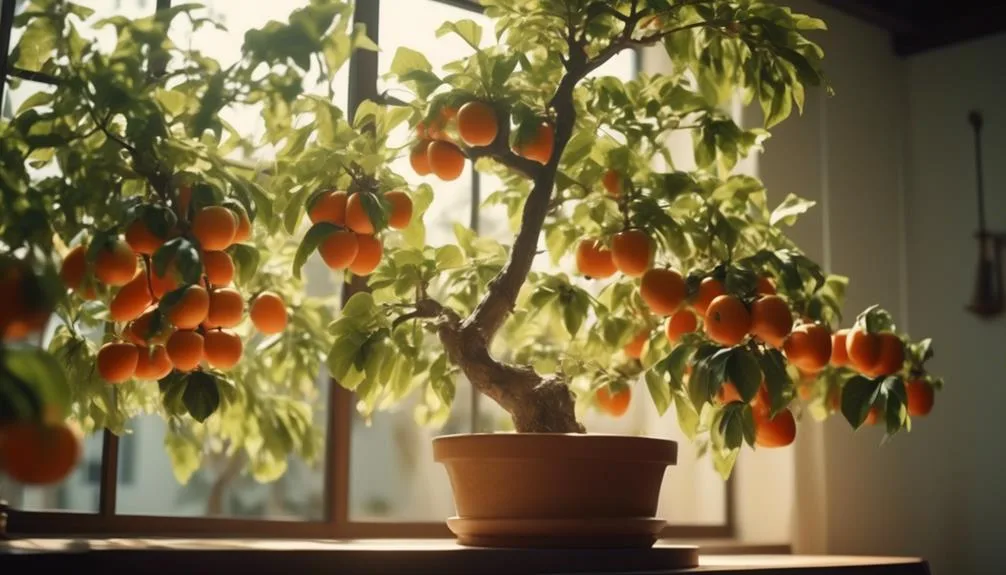Growing persimmon trees indoors may seem like a challenge, but it's actually possible with the right care.
Having your own fruit-bearing tree inside your home is intriguing, but it comes with its own set of obstacles.
Let's explore the factors involved in cultivating these trees indoors and how you can potentially overcome the challenges.
Key Takeaways
- Suitable persimmon tree varieties can be grown indoors with proper care and attention to lighting, temperature, and humidity requirements.
- Indoor persimmon trees should be placed near a south-facing window to receive 6-8 hours of direct sunlight daily, supplemented with grow lights if necessary.
- Watering should be done when the top inch of soil feels dry, avoiding both overwatering and letting the soil dry out completely. Balanced fertilizer should be used during the growing season.
- Regular inspection of the tree for pests, diseases, and dead or diseased branches is necessary. Organic pesticides or insecticidal soap can be used to treat infestations, and pruning is important for maintaining tree health and structure.
Suitable Persimmon Tree Varieties for Indoor Growth
When selecting suitable persimmon tree varieties for indoor growth, consider the space available and the desired fruit characteristics to ensure a successful and rewarding experience.
For the best lighting, choose a spot near a south-facing window to provide ample sunlight, or use grow lights to supplement natural light.
Persimmon trees thrive in well-draining soil with a slightly acidic to neutral pH, so ensure the soil requirements are met by using a high-quality potting mix specifically designed for fruit trees.
Additionally, consider the size of the mature tree when selecting a container, as persimmon trees have extensive root systems and may require repotting as they grow.
Indoor Growing Conditions for Persimmon Trees
To create optimal indoor growing conditions for your persimmon trees, it's essential to consider the space available, lighting requirements, and soil quality based on the desired fruit characteristics.
- Light Requirements: Ensure your persimmon tree receives at least 6-8 hours of direct sunlight per day. Supplemental grow lights can be used during the winter months if natural light is insufficient.
- Temperature Control: Maintain a consistent temperature of 60-70°F during the day and slightly cooler at night to mimic the tree's natural outdoor environment.
- Soil Composition: Use well-draining, loamy soil with a slightly acidic pH level of 6.0-6.5. Consider adding organic matter to improve soil structure and fertility.
- Humidity Levels: Aim for moderate humidity levels, around 50-60%. Consider using a humidifier if the air indoors is too dry.
Container Selection and Placement for Indoor Persimmon Trees
For optimal growth and health of your indoor persimmon tree, careful consideration of container selection and strategic placement is crucial. When selecting containers, opt for ones that are at least 24 inches in diameter and have drainage holes to prevent waterlogging. A 2:1:1 mix of potting soil, peat moss, and pine bark will provide excellent drainage and aeration for the roots. Place the container in a south-facing window to ensure your persimmon tree receives the 6-8 hours of sunlight it requires daily. If a south-facing window is not available, consider using grow lights to supplement natural light. Indoor temperatures of 60-70°F are ideal for persimmon trees, so avoid placing them near drafts or heating vents. Ensuring proper container selection and optimal placement will set the stage for a thriving indoor persimmon tree.
| Considerations | Details |
|---|---|
| Selecting containers | At least 24" in diameter, with drainage holes |
| Optimal placement | South-facing window for 6-8 hours of sunlight daily |
| Light requirements | Supplement with grow lights if needed |
| Temperature | Maintain indoor temperatures of 60-70°F |
Caring for Indoor Persimmon Trees: Watering, Fertilizing, and Pruning
Wondering how to best care for your indoor persimmon tree when it comes to watering, fertilizing, and pruning? Here are some essential tips to help your persimmon tree thrive indoors:
- Watering Frequency: Check the soil moisture regularly and water when the top inch of the soil feels dry. Persimmon trees prefer slightly moist soil, so avoid overwatering or letting the soil dry out completely.
- Fertilizing: During the growing season, use a balanced fertilizer to nourish your persimmon tree. Follow the instructions on the fertilizer package for the correct application and frequency.
- Pruning Techniques: Regularly inspect your persimmon tree for dead or diseased branches, and prune them to maintain overall tree health. Additionally, consider shaping the tree by pruning to encourage a strong and well-balanced branch structure.
Potential Challenges and Solutions for Growing Persimmon Trees Indoors
After ensuring that your indoor persimmon tree is well cared for with proper watering, fertilizing, and pruning, it's important to be aware of potential challenges and their solutions in order to maintain the tree's health and vitality.
One challenge when growing persimmon trees indoors is the susceptibility to pests and diseases such as spider mites, aphids, and leaf spot. To combat these issues, regularly inspect the tree for any signs of infestation and promptly treat with organic pesticides or insecticidal soap. Additionally, ensure proper air circulation and avoid overwatering to prevent disease development.
Another challenge is providing adequate lighting, especially during winter months. To overcome this, consider using artificial lighting such as grow lights to supplement natural light and ensure the tree receives at least 12-14 hours of light daily.
Conclusion
In nurturing a suitable variety of persimmon trees indoors and providing the right conditions, along with attentive watering, fertilizing, and pruning, you can savor the sweet fruit of your labor.
Remember to address challenges promptly for a fruitful indoor garden.
Happy growing!

